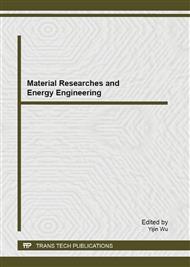[1]
Mondal, I., Dutta, A.K.: An Analytical Gate Tunneling Current Model for MOSFETs Having Ultrathin Gate Oxides. Electron Devices, IEEE Trans., Vol. 55(2008), p.1682.
DOI: 10.1109/ted.2008.924443
Google Scholar
[2]
Mukhopadhyay, S., Neau, C., Cakici, R.T.: Gate Leakage Reduction for Scaled Devices Using Transistor Stacking. Very Large Scale Integration (VLSI) Systems, IEEE Transactions, Vol. 11(2003), p.716.
DOI: 10.1109/tvlsi.2003.816145
Google Scholar
[3]
Information on http: /www. itrs. net.
Google Scholar
[4]
Lin, C.H., Kuo, et al.: Partitioned gate tunneling current model considering distributed effect for CMOS devices with ultra-thin gate oxide. Electronics Letters, Vol. 42(2006), p.182.
DOI: 10.1049/el:20064060
Google Scholar
[5]
N. Yang, W. K. Henson, J. Wortman. : A Comparative Study of Gate Direct Tunneling and Drain Leakage Currents in N-MOSFETs with sub-2100-nm Gate oxides. Electron Devices, IEEE Trans., Vol. 47(2000), p.1634.
DOI: 10.1109/16.853042
Google Scholar
[6]
Garima Joshi, Singh, D.N., Thangjam, S.: Effect of Temperature Variation on Gate Tunneling Currents in Nanoscale MOSFETs. NANO '08. 8th IEEE Conference, (2008), p.37.
DOI: 10.1109/nano.2008.19
Google Scholar
[7]
J. Cai, C. T. Sah: Gate tunneling currents in ultra-thin oxide metal-oxide-silicon transistors. Appl. Phy., Vol. 89(2001), p.2272.
DOI: 10.1063/1.1337596
Google Scholar
[8]
Pavel, A.A., Sharma, A., Islam, N.: An Improved Model for Calculating Tunneling Current in Nanocrystal Memory. Electron Device Letters, Vol. 29(2008), p.1370.
DOI: 10.1109/led.2008.2006633
Google Scholar
[9]
K. Maitra, N. Bhat: Analytical approach to integrate the different components of direct tunneling current through ultra-thin gate oxides in n-channel metal-oxide-semiconductor field-effect transistors. Appl. Phy., Vol. 93(2003), p.1064.
DOI: 10.1063/1.1527710
Google Scholar
[10]
K. Cao, W. C. Lee, W. Liu, et al.: BSIM4 Gate Leakage Model including Source-Drain Partition. IEDM Technical Digest., (2000), p.815.
DOI: 10.1109/iedm.2000.904442
Google Scholar
[11]
S. Mukhopadhyay, C. Neau, R. Cakici: Gate leakage reduction for scaled devices using transistor stacking. VLSI Syst., IEEE Trans. Vol. 11(2003), p.716.
DOI: 10.1109/tvlsi.2003.816145
Google Scholar


